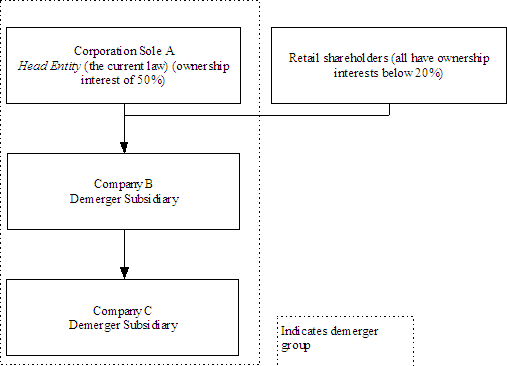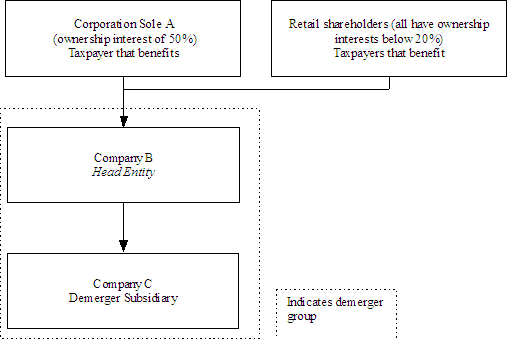Explanatory Memorandum
(Circulated by the authority of the Deputy Prime Minister and Treasurer, the Hon Wayne Swan MP)Chapter 3 - CGT and business restructures - Part 2: CGT demerger relief
Outline of chapter
3.1 Part 2 of Schedule 2 to this Bill excludes an entity from being a member of a demerger group if the entity is a corporation sole or a complying superannuation entity.
3.2 All legislative references in this chapter are to the Income Tax Assessment Act 1997 unless otherwise stated.
Context of amendments
3.3 Division 125 allows taxpayers to choose to obtain a capital gains tax (CGT) roll-over for a capital gain or capital loss that arises on their interest in a company or trust because of the demerger of an entity from the group of which the company or trust is the head entity. This roll-over aims to make sure that CGT is not an impediment to business restructures where there is no real change in the underlying economic ownership of the entities involved.
3.4 Under a demerger, a CGT event happens to a taxpayer's interest in the head entity and they receive a new interest in the entity that is demerged. The roll-over allows the taxpayer to defer any capital gain or capital loss realised because of the demerger.
3.5 Certain capital gains or capital losses made by a demerging entity are also disregarded under Division 125. Certain dividends arising under a demerger are tax exempt.
3.6 For the relief to be available, the demerger must happen to a 'demerger group'. A demerger group is comprised of the head entity of the group and one or more demerger subsidiaries (see sections 125-65 and 125-70).
3.7 If the head entity of a demerger group is a corporation sole, the corporation sole cannot demerge any of its interests in the demerger group because the corporation sole does not issue ownership interests and therefore does not have shareholders to whom it could demerge its interests in the demerger group. If an entity owned by the corporation sole demerged any of its interests in the demerger group, Division 125 relief does not currently apply because the corporation sole owns ownership interests in that entity and the corporation sole is still the head entity of the 'demerger group' as defined under Division 125 (see subsections 125-65(1) and (3)).
3.8 If the head entity of a demerger group is a superannuation entity, it is unable to demerge any of its interests in the demerger group. A 'demerger', as defined by Division 125, cannot happen to a demerger group if the head entity or the demerged entity is a trust which is a superannuation fund (see paragraph 125-70(1)(g)). Even if complying superannuation entities could access Division 125 demerger relief, they would most likely breach relevant regulatory requirements of the Superannuation Industry (Supervision) Act 1993 .
3.9 In summary, groups that have a corporation sole or a complying superannuation entity as their head entity are unable to benefit from demerger relief because they can only demerge, or realistically demerge, by treating an entity below the corporation sole or complying superannuation entity as the head entity of a demerger group that does not include the corporation sole or complying superannuation entity.
Summary of new law
3.10 Part 2 of this Schedule excludes an entity from being a member of a demerger group if the entity is a corporation sole or a complying superannuation entity. This allows an entity owned by the corporation sole or complying superannuation entity to qualify as the head entity of a demerger group.
3.11 The new head entity will be able to demerge entities from the demerger group and qualify for Division 125 relief.
Comparison of key features of new law and current law
| New law | Current law |
| Corporations sole and complying superannuation entities are not members of demerger groups. This allows an entity owned by the corporation sole or complying superannuation entity to be the head entity of a demerger group. This entity can now demerge its interests in a member of the demerger group and its owners potentially benefit from Division 125 relief. | Corporations sole and complying superannuation entities can be the head entity of a demerger group but are unable to demerge lower level entities in the group and qualify for Division 125 relief. |
Detailed explanation of new law
3.12 These amendments ensure that corporations sole and complying superannuation entities are not members of demerger groups. [Schedule 2, item 12, subsection 125-65(2A)]
3.13 This overcomes a problem with the current provisions which do not allow for demerger relief to accommodate situations where the head entity of a demerger group is a corporation sole or a complying superannuation fund.
3.14 In the corporation sole case, nobody holds an ownership interest in the head entity, and accordingly, no demerger by the head entity can occur. This is because there are no owners of the head entity to whom ownership interests in a demerged entity could be issued as required by section 125-55.
3.15 Similarly, a complying superannuation entity that is the head entity of a demerger group is unable to demerge interests in a member of the group under the existing law.
3.16 These amendments prevent a corporation sole or complying superannuation entity from being a member of a demerger group, and hence from being the head entity of a demerger group. This allows an entity owned by the corporation sole or complying superannuation entity to qualify as the head entity of a demerger group. That head entity can then demerge its interests in a member of the demerger group to the owners of the head entity.
3.17 The excluded corporation sole or complying superannuation entity now can qualify for the CGT roll-over (as the taxpayer under section 125-55) when a capital gain or capital loss arises on its interest in the head entity as part of a demerger. If relevant, the exemption for demerger dividends may also be available to the corporation sole or complying superannuation entity.
3.18 Diagrams 3.1 and 3.2 illustrate two demerger scenarios:
- •
- where a corporation sole cannot demerge (the current law); and
- •
- a demerger under the amended tax treatment with a corporation sole as an owner of the head entity of a demerger group redefined under the amendments.
Diagram 3.1 : Corporation sole 'cannot demerge'

Corporation Sole A cannot demerge its subsidiaries (Company B or Company C) as it does not have shareholders (owners) to whom it can demerge its interests in Company B or Company C. This also restricts the retail shareholders from benefiting from demerger relief.
Diagram 3.2 : Corporation sole as owner of a head entity of a demerger group

These amendments exclude Corporation Sole A from being a member of a demerger group. This allows Company B to be the new head entity of a demerger group. Company B can demerge its interests in Company C to Corporation Sole A and Company B's retail shareholders, who can benefit from the demerger relief.
Application and transitional provisions
3.19 Part 2 of this Schedule applies to CGT events happening after 7.30 pm (by legal time in the Australian Capital Territory) on 11 May 2010. The amendments are beneficial to taxpayers. [Schedule 2, item 14] Consequential amendments
3.20 An amendment is made to paragraph 125-70(1)(g) so that it refers to a 'non-complying superannuation fund' rather than a 'superannuation fund'. The existing paragraph 125-70(1)(g) precludes a demerger from happening where the original interests or new interests are in a superannuation fund. The broad coverage of 'superannuation fund' is narrowed to non-complying superannuation funds because the main amendment prevents a complying superannuation fund from being part of a demerger group, which takes them outside the scope of the application of the existing paragraph 125-70(1)(g). [Schedule 2, item 13, paragraph 125-70(1)(g)]
